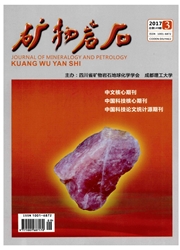

 中文摘要:
中文摘要:
泰国北部清迈带洋岛型火山岩常被下石炭统及上二叠统浅水碳酸盐岩覆盖,主要岩石类型有夏威夷岩和钾质粗面玄武岩。以碱性系列为主,极个别亚碱性。主要化学成分以高TiO2、高P2O2和中K2O为特征;稀土元素强烈的轻稀土富集右倾斜型;微量元素模式呈K—Ti上隆富集型;多种成分投图落于洋岛玄武岩区及碱性玄武岩区,属于洋岛型火山岩。与中国云南德歙、耿马(昌宁-孟连带)洋岛玄武岩类似,它们是清迈带古特提斯洋壳的极重要组成部分。
 英文摘要:
英文摘要:
The oceanic island volcanic rocks in the Chiang Mai zone, northern Thailand,were usually covered by Lower Carboniferous and Upper Permian shallow-water carbonate rocks, with the Hawaii rocks and potash trachybasalt being the main rock types. Alkaline series was dominant with sub-alkaline series occurring in few cases. Geochemical characteristics of the rocks were described as follows: the major chemical compositions were characterized by high TiO2 ,and PzOs, and medium K20. Rare-earth elements were characterized by right-inclined strong LREE-enrichment patterns and the trace element patterns were of the upward-bulging K-Ti enrichment type. Multi-component plots fell within the fields of oceanic island basalts and alkali basalts,indicating that they belong to oceanic island-type volcanic rocks, similar to the equivalents in Deqin and Gengma (Changning-Menglian zone) of Yunnan rocks are part of the oceanic crust of the Chiang Province, China. Actually, these oceanic volcanic Mai zone of the Paleo-Tethyan Ocean.
 同期刊论文项目
同期刊论文项目
 同项目期刊论文
同项目期刊论文
 Study on the geochemical characteristics of ocean-ridge and oceanic-island volcanic rocks in the Nan
Study on the geochemical characteristics of ocean-ridge and oceanic-island volcanic rocks in the Nan Geochemical characteristics of island-arc volcanic rocks in the Nan-Nam Pat-Phetchabun zone, norther
Geochemical characteristics of island-arc volcanic rocks in the Nan-Nam Pat-Phetchabun zone, norther Study on the geochemical characteristics of arc-volcanic rocks in the Chiang Rai-Lampang belt of nor
Study on the geochemical characteristics of arc-volcanic rocks in the Chiang Rai-Lampang belt of nor Geochemical constraints on the depositional environment of Upper Devonian radiolarian cherts from Lo
Geochemical constraints on the depositional environment of Upper Devonian radiolarian cherts from Lo Geochemistry of Middle Triassic Radiolarian Chert from Northern Thailand and Their Paleogeographic I
Geochemistry of Middle Triassic Radiolarian Chert from Northern Thailand and Their Paleogeographic I Geochemical characteristics of the oceanic islandtype volcanic rocks in the Chiang Mai zone, norther
Geochemical characteristics of the oceanic islandtype volcanic rocks in the Chiang Mai zone, norther 期刊信息
期刊信息
